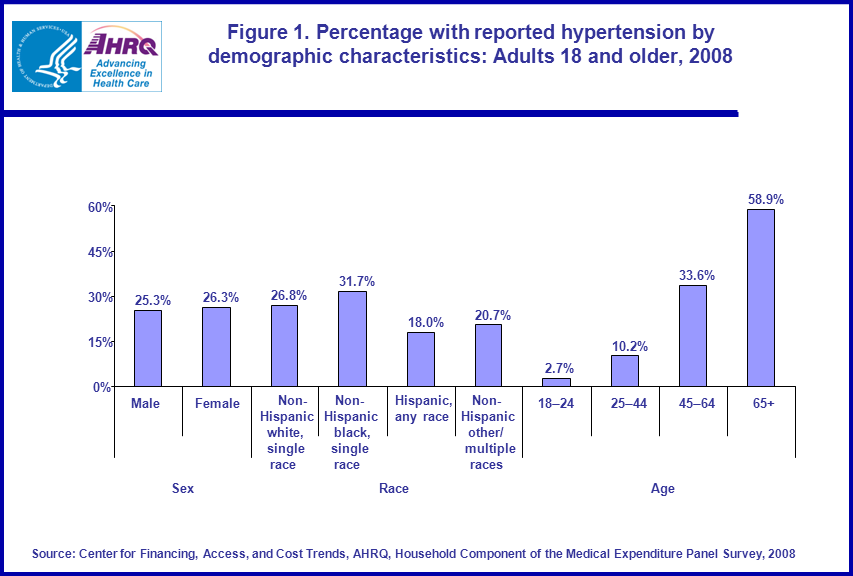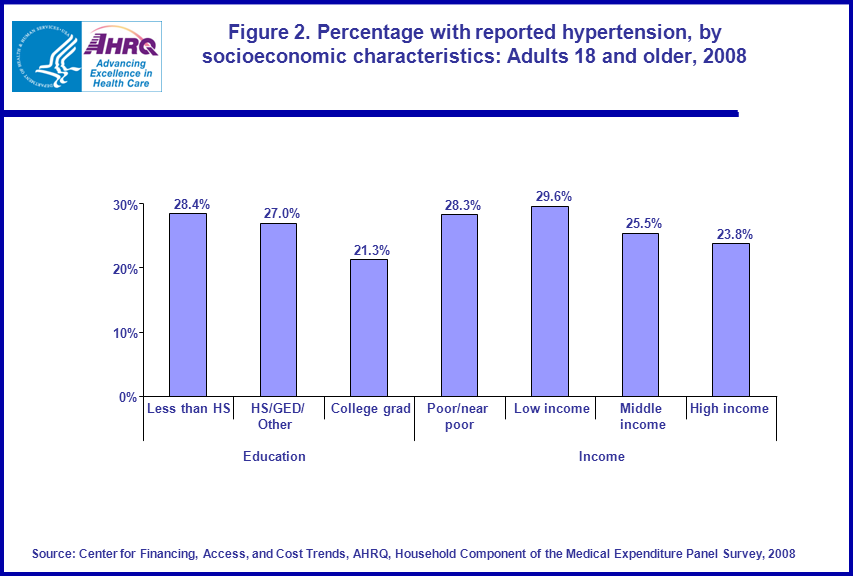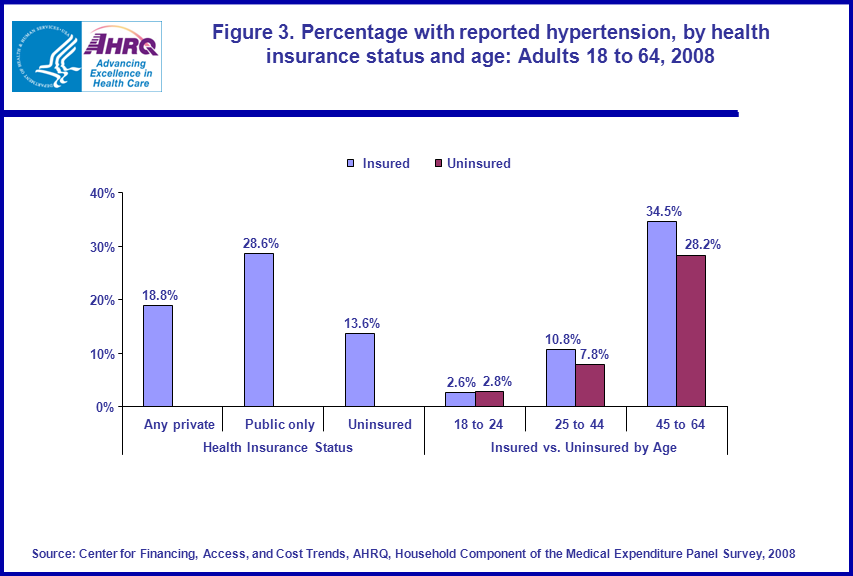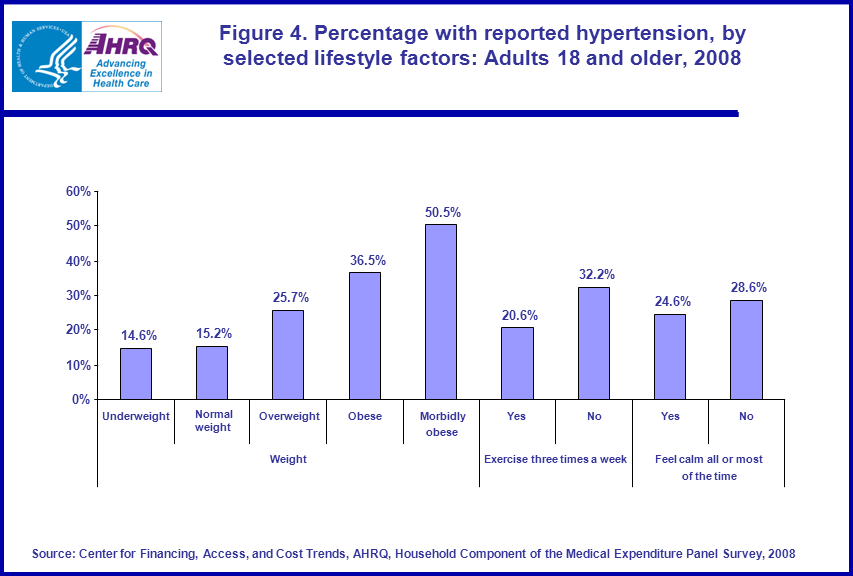
|
|
Font Size:
|
||||
|
|
|
|
||||
STATISTICAL BRIEF #315:
Hypertension in America: Estimates for the U.S. Civilian Noninstitutionalized Population, Age 18 and Older, 2008
Highlights
- 25.8 percent or 59.4 million adults were reported to have been told at two or more different health care visits that they have hypertension.
- The percentage of non-Hispanic blacks ever diagnosed with hypertension was higher than for non-Hispanic whites (31.7 percent versus 26.8 percent), while the percentage among Hispanics was lower than for non-Hispanic whites (18.0 percent versus 26.8 percent).
- The percentage of overweight to morbidly obese adults ever diagnosed with hypertension was twice that of healthy weight adults (31.4 percent versus 15.2 percent).
- Among adults 18 to 64 years old, the uninsured were substantially less likely to have ever been diagnosed with hypertension than adults covered only by public health insurance (13.6 percent versus 28.6 percent), or covered by any private health insurance (13.6 percent versus 18.8 percent).
Introduction
Hypertension, commonly referred to as high blood pressure, is a serious medical condition which, if not controlled, can lead to more serious cardiovascular conditions. Lifestyle factors, such as exercise, weight control, and stress reduction, can affect the risk and impact of hypertension. MEPS data show that regular exercise, maintaining a healthy weight, and having a low level of stress are all associated with lower rates of hypertension.Data from the 2008 Medical Expenditure Panel Survey (MEPS) show that an estimated 25.8 percent of adults 18 years old and older had been told by a health care professional at two or more different medical visits that they had hypertension. An estimated 19.4 percent of adults with hypertension are unaware they have the condition.1
Diagnosed hypertension as reported by household respondents in the MEPS is not distributed evenly across all subgroups of adults. This Brief examines variation in the percentage of adults with diagnosed hypertension by race/ethnicity, age, educational attainment, family income, and insurance status. Adults were classified as having diagnosed hypertension if there was a response of "yes" to a survey question asking whether the adult had been told they had hypertension by a health care professional at two or more different medical visits.
All differences discussed in the text are statistically significant at the p < 0.05 level.
Findings
25.8 percent or 59.4 million adults were reported to have been told at two or more different health care visits that they have hypertension.Demographic and socioeconomic characteristics (see figures 1 and 2)
In 2008, there was no significant difference by gender in the proportion of adults who had ever been diagnosed with hypertension (about one-quarter of both women and men) (figure 1). However, the percentage of adults ever diagnosed with hypertension did vary across various race/ethnic groups and by age. The percentage was higher among non-Hispanic black adults (31.7 percent) compared to non-Hispanic white adults (26.8 percent), while the rate among Hispanics (18.0 percent) was lower than that of non-Hispanic whites and non-Hispanic blacks. A positive relationship existed between diagnosed hypertension and age (2.7 percent among persons 18-24 years old and 58.9 percent among persons 65 years and older).
Health insurance status (see figure 3)
Among adults 18 to 64 years old, the likelihood of ever being diagnosed with hypertension was lowest among uninsured adults (13.6 percent) and highest among those covered only by public insurance (28.6 percent). The rate for adults with any private health insurance was in between (18.8 percent).
When comparing the insured to the uninsured figure 3 shows that for young adults there was no difference in the percent with diagnosed hypertension, however uninsured adults 25 years old and older were less likely to have hypertension.
Lifestyle factors (see figure 4)
Healthy lifestyles can help reduce the risk and impact of hypertension. Figure 4 shows that the percentage of adults ever diagnosed with hypertension increased progressively with increasing body weight (as reported by the household respondent). Specifically, the percentage of overweight adults with diagnosed hypertension was 25.7 percent compared to 15.2 percent among normal weight adults. More striking, however, was the 3.3 times higher percentage of morbidly obese adults ever diagnosed with hypertension compared to normal weight adults (50.5 percent versus 15.2 percent, respectively). About 62 percent of the adults with diagnosed hypertension that were overweight, obese, or morbidly obese were advised by a health professional to eat fewer high fat or high cholesterol foods (data not shown in figure).
The percentage of adults ever diagnosed with hypertension also varied by exercise activity and stress level. The percentage among adults who reported that they spent half an hour or more in moderate or vigorous physical activity at least three times a week was lower than among persons not reporting this level of exercise activity (20.6 percent and 32.2 percent, respectively). About 59 percent of the adults with hypertension were advised by a health professional to exercise more (data not shown in figure). Regarding stress, 24.6 percent of adults who reported that they felt calm all or most of the time had been diagnosed with hypertension compared to 28.6 percent of adults that reported feeling calm only some, little or none of the time.
Considering the above lifestyle factors together, 13.9 percent of all adults reported that they exercised regularly, had a normal weight, and felt calm all or most of the time. Among these lower risk persons, about 12.3 percent had hypertension compared to 28.3 percent of the rest of the adult population (data not shown in figure).
The 2008 MEPS data also show that 17.7 percent of adults who had ever been diagnosed with hypertension were current smokers and that about 67.6 percent of those had been advised by a doctor to quit smoking within the past 12 months (data not shown in figure).
Data Source
The estimates shown in this Statistical Brief are drawn from MEPS public use file, MEPS HC-121: 2008 Full Year Consolidated Data File.Definitions
HypertensionThe question used to identify persons with hypertension is, "Were you told on two or more different visits that you had hypertension, also called high blood pressure?". The household respondent was asked this question about themselves and the other adults living in the household.
Body Mass Index (BMI)
- Underweight = BMI is less than 18.5
- Normal Weight = BMI is between 18.5-24.9 inclusive
- Overweight = BMI is between 25.0-29.9 inclusive
- Obesity = BMI is between 30.0-39.9 inclusive
- Morbidly Obese = BMI greater than or equal to 40.0
The following question from the Self-Administered Questionnaire was used as a measure for stress: "How much of the time during the past 4 weeks have you felt calm and peaceful? All of the time, most of the time, some of the time, a little of the time, or none of the time?" The assumption is that people reporting feeling calm and peaceful only some of the time, a little of the time, or none of the time are potentially experiencing unhealthy amounts of stress.
Education level
Respondents were asked to report the highest grade or year of schooling ever completed by each family member as of the date of the interview: not a high school graduate (grade less than 12), high school graduate/GED/Other (grade 12 or equivalent, or some college), and college graduate.
Poverty status
Each person in the survey sample was classified according to the total yearly income of his or her family. Within a household, all individuals related by blood, marriage, or adoption were considered to be a family. Personal income from all family members was summed to create family income. Poverty status is the ratio of family income to the federal poverty thresholds, which control for family size and age of the head of family. Categories are defined as follows:
- Poor/Near poor: This refers to persons in families with incomes under 125 percent of the poverty line and also includes persons with negative income.
- Low income: This category includes persons in families with income over 125 percent through 200 percent of the poverty line.
- Middle income: This category includes persons in families with income over 200 percent through 400 percent of the poverty line.
- High income: This category includes persons in families with income over 400 percent of the poverty line.
Health insurance status was constructed hierarchically in the following order:
- Any private coverage: Private health insurance coverage was defined as having nonpublic insurance for all or part of the year that provided coverage for hospital and physician care (including Medigap coverage). TRICARE was considered private coverage
- Public only coverage: Adults were considered to have public only health insurance coverage if they were not covered by private insurance, and they were covered by Medicare, Medicaid, or other public hospital and physician coverage for all or part of the year.
- Uninsured: Adults classified as uninsured did not have public or private health insurance coverage at any time during the year. People covered only by noncomprehensive state-specific programs (e.g., Maryland Kidney Disease Program) or private single-service plans (e.g., coverage for dental or vision care only, coverage for accidents or specific diseases) were not considered to be insured.
About MEPS-HC
The Medical Expenditure Panel Survey (MEPS) collects nationally representative data on health care use, expenditures, sources of payment, and insurance coverage for the U.S. civilian noninstitutionalized population. MEPS is cosponsored by the Agency for Healthcare Research and Quality (AHRQ) and the National Center for Health Statistics (NCHS). This Statistical Brief summarizes data concerning the prevalence of diagnosed hypertension in the United States during 2008 as reported by the designated household respondent during the household interview. Item nonresponse rates for the items reported in this Brief ranged from 0 percent to 5.6 percent. No adjustments were made for item nonresponse; they are excluded from both the numerator and denominator of estimates. More information about MEPS can be found on the MEPS Web site at http://www.meps.ahrq.gov/. For a detailed description of the MEPS survey design see Methodology Report #22: Sample Design of the Medical Expenditure Panel Survey Household Component, 1998-2007.References
For a detailed description of the MEPS-HC survey design, sample design, and methods used to minimize sources of nonsampling error, see the following publications:Cohen, J. Design and Methods of the Medical Expenditure Panel Survey Household Component. MEPS Methodology Report No. 1. AHCPR Pub. No. 97-0026. Rockville, MD: Agency for Health Care Policy and Research, 1997. http://www.meps.ahrq.gov/mepsweb/data_files/publications/mr1/mr1.shtml
Cohen, S. Sample Design of the 1996 Medical Expenditure Panel Survey Household Component. MEPS Methodology Report No. 2. AHCPR Pub. No. 97-0027. Rockville, MD: Agency for Health Care Policy and Research, 1997. http://www.meps.ahrq.gov/mepsweb/data_files/publications/mr2/mr2.shtml
Cohen, S. Design Strategies and Innovations in the Medical Expenditure Panel Survey. Medical Care, July 2003: 41(7)Supplement: III-5–III-12.
Ezzati-Rice, TM, Rohde, F, Greenblatt, J, Sample Design of the Medical Expenditure Panel Survey Household Component, 1998 – 2007. Methodology Report No. 22. March 2008. Agency for Healthcare Research and Quality, Rockville, MD. http://www.meps.ahrq.gov/mepsweb/data_files/publications/mr22/mr22.shtml
Sung Sug Yoon, Yechiam Ostchega, and Tatiana Louis Recent Trends in the Prevalence of High Blood Pressure and its Treatment and Control, 1999 – 2008. NCHS Data Brief No. 48, October 2010.
Suggested Citation
Carroll, W. Hypertension in America: Estimates for the U.S. Civilian Noninstitutionalized Population, Age 18 and Older, 2008. March 2011. Agency for Healthcare Research and Quality, Rockville, MD. http://www.meps.ahrq.gov/mepsweb/data_files/publications/st315/stat315.shtmlAHRQ welcomes questions and comments from readers of this publication who are interested in obtaining more information about access, cost, use, financing, and quality of health care in the United States. We also invite you to tell us how you are using this Statistical Brief and other MEPS data and tools and to share suggestions on how MEPS products might be enhanced to further meet your needs. Please e-mail us at mepspd@ahrq.gov or send a letter to the address below:
Steven B. Cohen, PhD, Director
Center for Financing, Access, and Cost Trends
Agency for Healthcare Research and Quality
540 Gaither Road
Rockville, MD 20850
1 Sung Sug Yoon, Yechiam Ostchega, and Tatiana Louis Recent Trends in the Prevalence of High Blood Pressure and its Treatment and Control, 1999 – 2008. NCHS Data Brief No. 48, October 2010.
 |
||||||||||||||||||||||||||||||||||||||||||||||||||
|
||||||||||||||||||||||||||||||||||||||||||||||||||
|
|
||||||||||||||||||||||||||||||||||||||||||||||||||
 |
||||||||||||||||||||||||||||||||||||||||||||||||||
|
||||||||||||||||||||||||||||||||||||||||||||||||||
|
|
||||||||||||||||||||||||||||||||||||||||||||||||||
 |
||||||||||||||||||||||||||||||||||||||||||||||||||
|
||||||||||||||||||||||||||||||||||||||||||||||||||
|
|
||||||||||||||||||||||||||||||||||||||||||||||||||
 |
||||||||||||||||||||||||||||||||||||||||||||||||||
|
||||||||||||||||||||||||||||||||||||||||||||||||||
|
|
||||||||||||||||||||||||||||||||||||||||||||||||||


